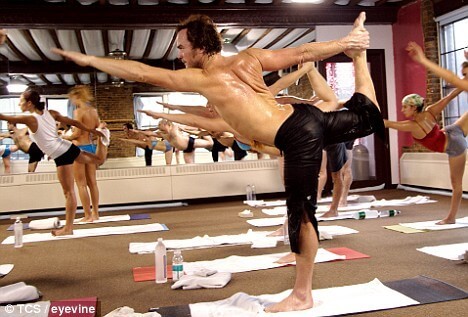What HOT yoga can do for you
At 6ft 3in and with a body-fat content of just 6.5 per cent, tennis ace Andy Murray appears to be leaner, stronger and having more success on court than earlier this year.
Witness his performance at the recent US Open when he outplayed Wimbledon champion Rafael Nadal before losing to Roger Federer in the final.
Murray's secret? Like Elle Macpherson and Daniel Craig, he is a convert to Bikram yoga.
He was introduced to it by his strength and conditioning coach, Matt Little, to improve his flexibility.
But, performed in sweltering rooms heated to 43C, just what is so special about this steamy form of yoga?
Walk into a typical Bikram studio, where vents pump steam into the room from all sides, and you're hit by a wave of sauna-like intensity.
Everyone is equipped with a towel and a two-litre bottle of water, while the teacher encourages pupils to stretch themselves.
Hot Bikram Yoga in Fulham, West London, where Murray goes regularly for a steamy stretch, counts Olympic athletes, Fulham footballers and tennis professionals among its members.
The reason for its popularity is clear. Stretching in high temperatures, say fans, allows you to push your body twice as far – which means you really see results.
And, as for all the sweating, it's a wonderful way to detox.
In each Bikram class, 26 poses and two breathing exercises are performed in a specific order.
Olga Allon, founder of Hot Bikram Yoga, says it provides a 'holistic workout' that stretches you physically and mentally, leaving you feeling balanced and calm.
'Bikram balances strength and flexibility and helps give cardiovascular endurance,' adds Allon. 'It may not look like much but balancing on one leg for minutes on end really makes your heart work. You also need focus, a level head and determination to hold such poses. This strengthens your mental capacity in ways that can be applied to other activities in life.'
The heat, she says, reduces the risk of injuries and means you can stretch further in comfort. 'The temperature in the room reflects that of muscles and body fluids once it has warmed up,' adds Allon. 'Your body relaxes and you can move it further. Those with stiff or arthritic joints find they can stretch into them more, without feeling pain or aching the next day.'
Overall, the series of poses and the order in which they are taught are designed to open up joints while balancing muscular alignment, improving the body's biomechanics.
'With stronger, longer muscles and better alignment, you have less strain on your joints and therefore less wear and tear,' says Allon.
'That's good news for athletes who want to reduce injury risk as well as those with back or neck pain or who want to cut their risk of arthritis.'
Proponents of Bikram claim it has other benefits. By boosting circulation and the body's innate healing capacity, for example, it will improve health problems such as asthma, arthritis or diabetes.
The technique is said to be particularly effective at aiding recovery from sports injuries. Its founder, Bikram Choudhury, developed it for that very reason.
After a severe knee injury from weight-training, he combined heat with yoga poses to assist circulation, enhance mobility and encourage healing. It helped Michelle Pernetta, founder of the Bikram Yoga Centre in West London, avoid knee surgery.
'I had damaged both knees [practising martial arts] in 1991, tearing the cartilage and straining the ligaments,' says Michelle, 41, whose recovery inspired her to introduce Bikram yoga to the UK 13 years ago.
'I couldn't bend either knee more than six inches, so was recommended for knee surgery.
'But I'd heard about Bikram yoga and its success for rehabilitation after injuries, so I flew to the US to train with Bikram. He promised me that in one year he'd "cure" my knees. After 12 months I could kneel and use my knees normally again.'
But can't Bikram be a stretch too far? Critics warn that, in the heat, you can push muscles beyond their natural limit and strain them. But Pernetta insists the method is safe.
'If you have high blood pressure or have had recent heart surgery, you can still do classes but will be advised to avoid certain postures,' she says. 'Our classes have a mix of people from beginners to advanced and of all ages. They push themselves only to a realistic level and take breaks when needed.'
-
Back pain: In a New York study, 80 per cent of patients immobilized by back injuries experienced markedly less pain after practicing yoga regularly
Wrist strain: At the University of Philadelphia, RSI sufferers undertook 11 yoga postures to increase the strength and flexibility of their wrists, arms, neck and shoulders. Their symptoms improved and there were signs of nerve regeneration.
Stress: Yoga initiates a process that turns off the fight-or-flight system and induces relaxation.
Insomnia: Yoga induces sleep as it calms and soothes the adrenal system and nerves.


